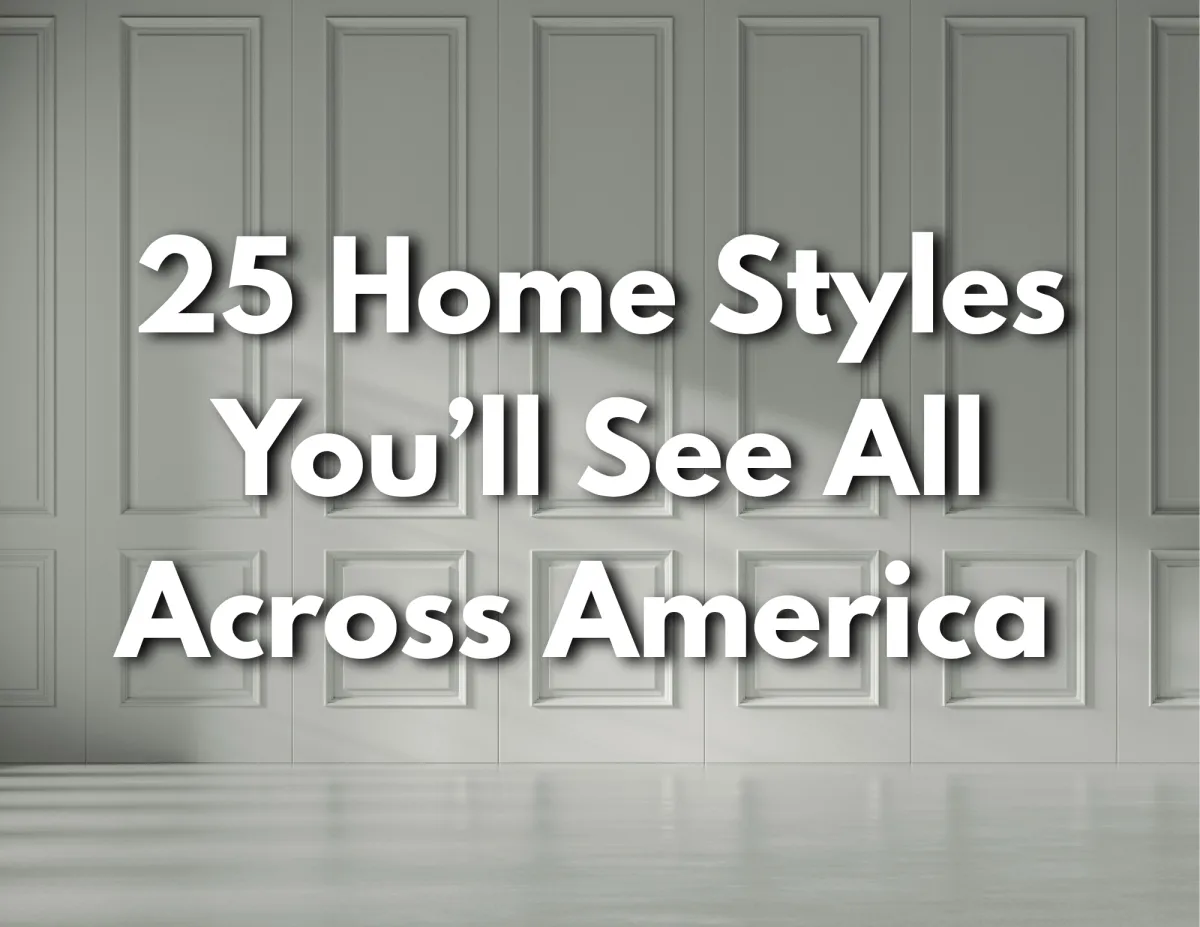How Much Is Your Home Worth?

25 Home Styles You’ll See All Across America (From Colonial to Contemporary)
Ever wondered how American home design has changed over the centuries? From saltbox cottages of the 1600s to sleek contemporary builds of today, each home style reflects the people, materials, and lifestyles of its time. Whether you're a design enthusiast, a homeowner, or shopping for your dream house, this guide walks you through 25 popular home styles in the U.S.
1. Saltbox
Popular: 1600s–1800s
Found In: New England
With its steeply pitched, asymmetrical roofline and central chimney, the saltbox home was designed for practicality in colonial America. The distinctive sloped back roof helped reduce tax assessments based on stories, while the straightforward rectangular structure made it easy and affordable to build. Inside, expect wide plank floors, exposed beams, and large hearth fireplaces.
2. Colonial
Popular: 1700s–Present
Found In: Northeast, Southeast
Colonial homes are the quintessential early American design. Characterized by a rectangular shape, gabled roofs, and symmetry on all sides, they often feature a central front door flanked by multi-pane windows. Interiors usually include formal living and dining rooms with central hallways and fireplaces. This style is one of the most enduring in American housing.
3. Georgian
Popular: 1700s–1830
Found In: East Coast
A fancier cousin of the Colonial, Georgian homes added elegance and grandeur through classical details such as pedimented doors, brick or stone facades, and decorative crown moldings. High ceilings, central staircases, and symmetrical layouts define this British-influenced design that was popular during the reigns of Kings George I–IV.
4. Federal
Popular: 1780s–1800s
Found In: East Coast
Federal homes evolved from Georgian styles but leaned into Roman and Greek influence, with tall narrow windows, fanlights above doors, and refined detailing. These homes often had two or three stories, brick exteriors, and elegant porticos. Interiors emphasized symmetry and balance, reflecting America’s fascination with democracy and classical ideals.
5. Greek Revival
Popular: 1820s–1860s
Found In: Southeast, Mid-Atlantic
Greek Revival homes channeled the look of ancient temples, complete with large white columns, porticos, and symmetrical facades. Often painted white to mimic marble, they became the dominant architectural style for Southern estates and public buildings. Inside, high ceilings and formal parlors created an atmosphere of grandeur.
6. Rowhouse
Popular: 1820s–Present
Found In: Boston, Brooklyn, D.C., Philadelphia
Rowhouses were designed for city living, built in continuous rows with shared walls. Efficient and space-conscious, they usually feature brick exteriors, modest front yards, and narrow layouts with multiple stories. Inside, you’ll often find tall ceilings and staircases with ornate details, especially in older buildings.
7. Italianate
Popular: 1840s–1880s
Found In: Northeast, Midwest
With tall windows, decorative corbels, and low-pitched or flat roofs, Italianate homes embraced romantic European influences. These were among the first homes to show off elaborate ornamentation. They were particularly popular in fast-growing industrial cities, offering vertical elegance and detailed craftsmanship.
8. Brownstone
Popular: 1840s–1890s
Found In: NYC, Boston, Philadelphia
Brownstones are multi-story townhouses made from reddish-brown sandstone. Famous for their stoops and bay windows, they became an iconic part of East Coast cityscapes. Often featuring tall ceilings, intricate woodwork, and small front gardens, they remain highly desirable in historic neighborhoods.
9. Tudor
Popular: 1850s–1970s
Found In: East Coast, Midwest
Drawing on medieval English architecture, Tudor homes include steep gabled roofs, brick and stucco facades, and half-timbering. Inside, exposed beams, wood paneling, and stone fireplaces add to the cozy, storybook charm. These homes became popular again in the 1920s suburban boom.
10. Victorian
Popular: 1850s–1920s
Found In: San Francisco, East Coast
Victorian homes are rich in detail and personality. They often include steep gabled roofs, towers or turrets, bay windows, and ornate trim. Painted in bold colors, they reflect the industrial era’s wealth and creativity. Interiors feature tall ceilings, decorative molding, and grand staircases.
11. Queen Anne
Popular: 1880s–1920s
Found In: California, Northeast
The most ornate of Victorian subtypes, Queen Anne homes are whimsical and eclectic. You’ll find patterned shingles, curved towers, wraparound porches, and asymmetrical facades. Inside, stained glass, carved woodwork, and fireplaces create a romantic, vintage feel.
12. Bungalow
Popular: 1900s–1940s
Found In: California, Midwest, Oregon
Bungalows are single-story homes designed for simplicity and efficiency. Their broad front porches, low-pitched roofs, and built-ins make them cozy and livable. Many include Craftsman details and were built in response to the growing middle class during America’s early 20th century expansion.
13. Craftsman
Popular: 1905–1930
Found In: California, Oregon, Seattle
Craftsman homes feature natural materials, wide porches, tapered columns, and exposed rafters. Interiors often include custom woodwork, built-in benches, and cozy layouts. Rooted in the Arts and Crafts movement, they value quality craftsmanship over mass production.
14. Prairie
Popular: 1905–1915
Found In: Midwest (Illinois, Wisconsin)
Made famous by Frank Lloyd Wright, Prairie-style homes reflect the flat landscape of the Midwest. Horizontal lines, rows of windows, and open floor plans promote harmony with the environment. They emphasize low profiles and built-in furnishings.
15. Spanish
Popular: 1920s–Present
Found In: California, Arizona, Southwest
Spanish-style homes are defined by white stucco walls, clay tile roofs, arched entryways, and wrought-iron accents. Often centered around courtyards, they are built for warm, dry climates and exude earthy elegance.
16. Mediterranean
Popular: 1920s–1960s
Found In: California, Florida, Texas
With stucco exteriors, red tile roofs, and balconies, Mediterranean homes pull from Spanish, Italian, and Moorish influences. Interiors often include mosaic tile, arched doorways, and breezy layouts ideal for coastal climates.
17. Storybook
Popular: 1920s–Present
Found In: California, Colorado
Whimsical and imaginative, storybook homes evoke fairy tales with steep gables, arched doors, stonework, and playful trim. These homes blend European fantasy with California creativity, especially popular in the 1920s.
18. Ranch
Popular: 1920s–Present
Found In: Nationwide
Ranch homes are known for their horizontal lines, open layouts, and connection to the outdoors. Built primarily on one level, they often feature sliding doors to patios, large front yards, and an emphasis on functional family living.
19. Split-Level
Popular: 1950s–Today
Found In: Midwest, East Coast suburbs
Split-level homes divide living spaces across multiple staggered levels. Typically, one enters into a foyer between floors, with short stairs leading up to bedrooms and down to family rooms. This design became a suburban staple in the baby boom era.
20. Midcentury Modern
Popular: 1940s–1960s
Found In: California, New York, Chicago, Palm Springs
Midcentury modern homes feature clean lines, floor-to-ceiling glass, flat or low-pitched roofs, and indoor-outdoor integration. They focus on simplicity, openness, and harmony with nature. Interiors emphasize minimalism and functional design.
21. A-Frame
Popular: 1950s–1990s
Found In: Colorado, Oregon, mountain areas
A-frame homes are recognized by their steep, triangle-shaped roofs that reach almost to the ground. Ideal for snowy environments, these homes often include large windows, open lofts, and cozy interiors perfect for weekend retreats.
22. Postmodern
Popular: 1980s–Today
Found In: California, Urban areas
Postmodern homes break the rules of modernist design by combining traditional forms with unexpected twists. Playful, ironic, and eclectic, they mix styles, colors, and textures to create buildings that are both expressive and functional.
23. Contemporary
Popular: 1990s–Present
Found In: Nationwide
Contemporary homes adapt to current design trends, focusing on open spaces, sustainability, and modern materials. Expect smart home integration, energy-efficient systems, and a blend of natural and industrial finishes.
24. Modern Farmhouse
Popular: 2000s–Today
Found In: Midwest, Tennessee, Texas
Modern farmhouse homes blend rustic charm with clean lines. Signature elements include black window frames, white siding, barn doors, and wide porches. Interiors are warm yet minimal, often featuring shiplap, reclaimed wood, and open floor plans.
25. Cape Cod
Popular: 1740s–Present (revived 1930s–1950s)
Found In: New England, Midwest
Originally built by early settlers, Cape Cod homes have steep roofs, central chimneys, and simple layouts. They saw a major revival in the post-WWII era as affordable housing solutions. Their symmetry and classic charm remain beloved today.
Quick Visual Glossary: Common Home Design Terms
Term
Meaning
Gable Roof
A triangular roof shape with two sloping sides that meet at a ridge.
Dormer
A window that projects vertically from a sloped roof.
Eaves
The lower edges of the roof that overhang the walls.
Clapboard Siding
Overlapping horizontal wooden boards used on Colonial homes.
Half-Timbering
Decorative wooden beams in walls, often seen in Tudor architecture.
Portico
A covered entrance supported by columns, typical in Greek Revival.
Over to You!
Which home style caught your eye? Have a favorite you dream of living in?
Tell us in the comments — or share this guide with someone who’s always pointing out pretty houses on your road trips!





